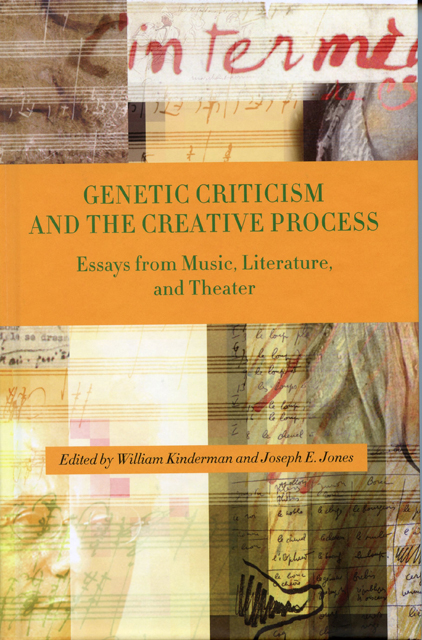Book contents
- Frontmatter
- Contents
- Acknowledgments
- Genetic Criticism and the Creative Process
- 1 Texts, Variants, and Variations: Evolving Contexts in Literature and Theater
- 2 Genetic Processes in Music: From Beethoven to Leroux
- 1 From Varieties of Genetic Experience to Radical Philology
- 2 Variant and Variation: Toward a Freudo-bathmologico-Bakhtino-Goodmanian Genetic Model?
- 3 The Genetic Record of a Voice: Variants in Barthes's Le Plaisir du texte
- 4 Can Genetic Criticism Be Applied to the Performing Arts?
- 5 “The hardy Laurel”: Beckett and Early Film Comedy
- 6 From Melodic Patterns to Themes: The Sketches for the Original Version of Beethoven's “Waldstein” Sonata, Op. 53
- 7 From Conceptual Image to Realization: Some Thoughts on Beethoven's Sketches
- 8 The Process within the Product: Exploratory Transitional Passages in Beethoven's Late Quartet Sketches
- 9 “They Only Give Rise to Misunderstandings”: Mahler's Sketches in Context
- 10 A Study of Richard Strauss's Creative Process: Der Rosenkavalier's “Presentation Scene” and “Schlußduett”
- 11 Genetic Criticism and Cognitive Anthropology: A Reconstruction of Philippe Leroux's Compositional Process for Voi(rex)
- Afterword
- Contributors
- Index
7 - From Conceptual Image to Realization: Some Thoughts on Beethoven's Sketches
Published online by Cambridge University Press: 02 March 2023
- Frontmatter
- Contents
- Acknowledgments
- Genetic Criticism and the Creative Process
- 1 Texts, Variants, and Variations: Evolving Contexts in Literature and Theater
- 2 Genetic Processes in Music: From Beethoven to Leroux
- 1 From Varieties of Genetic Experience to Radical Philology
- 2 Variant and Variation: Toward a Freudo-bathmologico-Bakhtino-Goodmanian Genetic Model?
- 3 The Genetic Record of a Voice: Variants in Barthes's Le Plaisir du texte
- 4 Can Genetic Criticism Be Applied to the Performing Arts?
- 5 “The hardy Laurel”: Beckett and Early Film Comedy
- 6 From Melodic Patterns to Themes: The Sketches for the Original Version of Beethoven's “Waldstein” Sonata, Op. 53
- 7 From Conceptual Image to Realization: Some Thoughts on Beethoven's Sketches
- 8 The Process within the Product: Exploratory Transitional Passages in Beethoven's Late Quartet Sketches
- 9 “They Only Give Rise to Misunderstandings”: Mahler's Sketches in Context
- 10 A Study of Richard Strauss's Creative Process: Der Rosenkavalier's “Presentation Scene” and “Schlußduett”
- 11 Genetic Criticism and Cognitive Anthropology: A Reconstruction of Philippe Leroux's Compositional Process for Voi(rex)
- Afterword
- Contributors
- Index
Summary
A contemporary illustration shows a room in Beethoven's last home in Vienna, a fair-sized apartment in the upper storey of a large building on the Glacis, the so-called House of the Black-Robed Spaniards (the Schwarzspanierhaus), in which he lived for the last eighteen months of his life. This wash drawing was made by Johann Nepomuk Hoechle a few days after Beethoven's death on March 26, 1827, and it is an act of homage and of mourning for his loss. In the foreground is the big piano that the maker, John Broadwood, had sent him in 1818. Burntout candlesticks stand on either side of the piano as daylight streams in from the window upon the fl oor and the empty chair, intensifying our awareness of Beethoven's death. Music lies helter-skelter on the piano though not on the piano rack, while two more stacks of music are piled up on the fl oor, as if someone had begun to straighten up the room.
The five-shelf bookcase shows a disordered array of scores and perhaps some of Beethoven's sketchbooks, which by now would have numbered more than seventy manuscripts of different sizes and formats. Elsewhere in the apartment there would have been piles of music, published and in manuscript, along with his fairsized library of books by classic and contemporary authors. The window opens out on Vienna, with the steeple of Saint Stephen's and other buildings visible in the distance. In this depiction we are seeing the artist's creative space from the inside, and the sound of his piano would have reverberated in the neighborhood. A curious touch is the inkpot and quill on the windowsill, suggesting that Beethoven could also write music or correspondence while leaning on the sill and looking out. Striking is the absence of a small writing desk or table next to the piano chair, for we know from his instructions to his pupil, Archduke Rudolph, that he always kept a small desk next to the piano so he could move from improvisation to writing and back again. But it appears from Gerhard von Breuning's description of the apartment that he had another room for composing that is not shown.
Another drawing, made by Joseph Daniel Böhm around 1820, shows Beethoven out walking with music paper clutched in his left hand.
- Type
- Chapter
- Information
- Genetic Criticism and the Creative ProcessEssays from Music, Literature, and Theater, pp. 108 - 122Publisher: Boydell & BrewerPrint publication year: 2009

